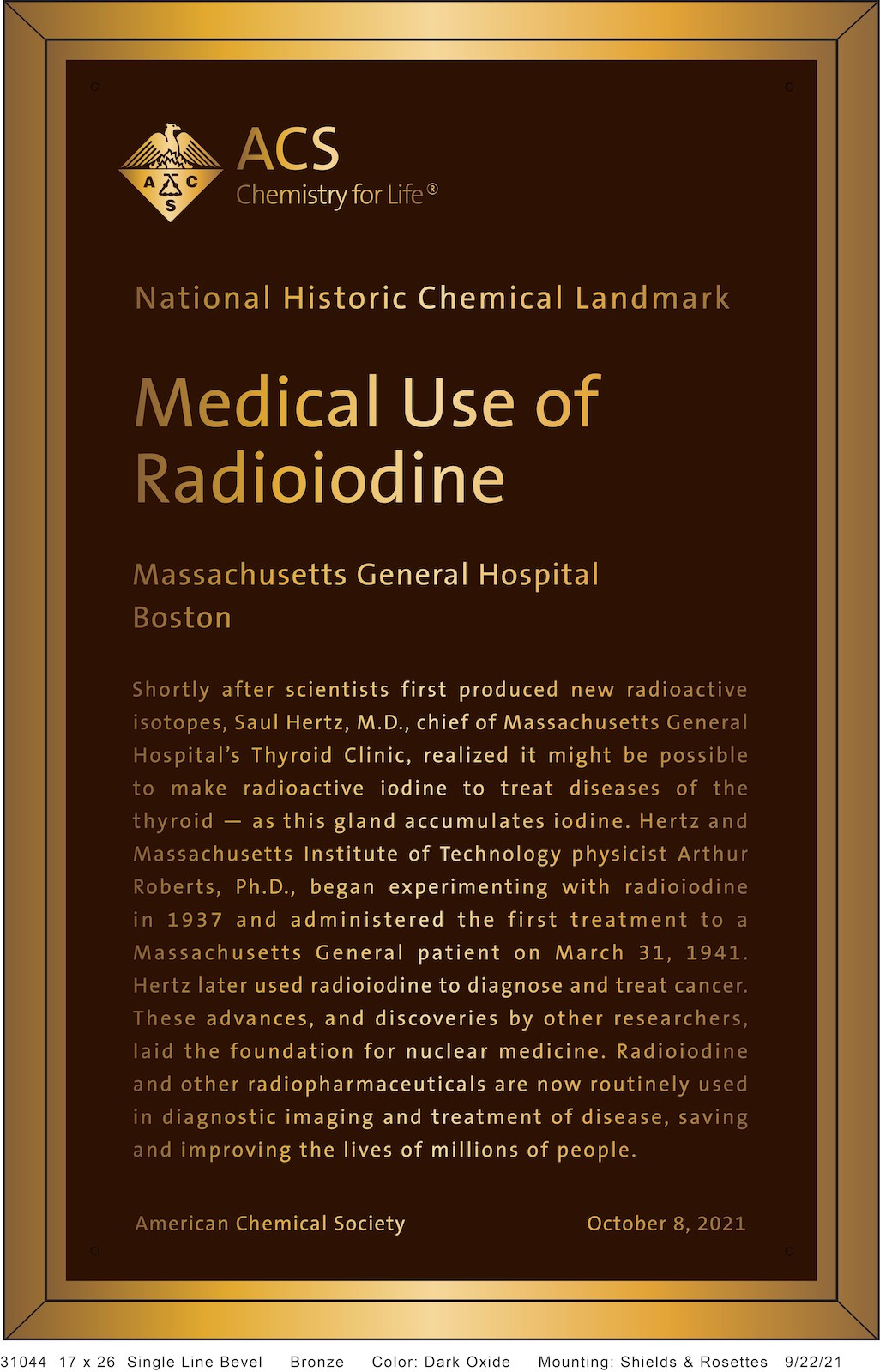Press Release5 Minute ReadNov | 1 | 2021
Honoring the Legacy of Saul Hertz and the Medical Uses of Radioiodine
David F.M. Brown, MDSomewhere in the basement of the Bulfinch Building, Dr. Hertz carried out experiments with results that would forever change medicine.
President, Massachusetts General Hospital
Visitors to the Bulfinch Lawn will soon notice a new commemorative plaque that has found its home among the lawn’s other notable pieces. The plaque honors the work of the late Saul Hertz, MD, for his discovery of the medical uses of radioiodine, and is the latest National Historic Chemical Landmark designated by the American Chemical Society (ACS).
Hertz was director of the MGH Thyroid Clinic from 1931 to 1943. It was during his years at Mass General that he learned of the development of artificial radioactivity and, in 1941, treated a patient for the first time with radioiodine for her overactive thyroid. Following its success, Hertz continued to study and develop radioiodine treatments until his death in 1950, providing the foundation for nuclear medicine, targeted precision medicine and modern-day cancer treatments. Today, radioiodine and other radioactive pharmaceuticals are routinely used in diagnostic imaging and treatment of disease.
“Somewhere in the basement of the Bulfinch Building, Dr. Hertz carried out experiments with results that would forever change medicine. What began as an investigation into thyroid disorders widened into an entirely new field: nuclear medicine,” said David F.M. Brown, MD, MGH president, during an Oct. 8 landmark dedication ceremony at Mass General. “Today, more than 10 million patients in the United States are treated each year with radioisotopes of various kinds. We are proud that the MGH was the site of such a significant medical milestone, and we thank the ACS for this extraordinary tribute to a pioneer in medicine.”
Additional speakers who paid tribute to Hertz were his daughter Barbara Hertz; Katherine Lee, PhD, of the ACS Board of Directors; Sumner Fanger, a close friend of Hertz; and Anna Sromek, PhD, past chair of the Northeastern section of the ACS.
The ACS established the National Historic Chemical Landmarks Program in 1992 to enhance public appreciation for the contributions of the chemical sciences to modern life in the nation and to encourage a sense of pride in their practitioners. Hertz is now among other notable scientists such as Thomas Edison; Edwin Land, the inventor of the Polaroid; Joseph Priestley, the discoverer of oxygen, who have been honored with a National Historic Chemical Landmark. The Hertz milestone at the MGH is only the second ACS landmark in Massachusetts.
“My father left an indelible impact on endocrinology, oncology, neurology, cardiology, radiology and, perhaps most importantly, on countless generations of patients worldwide,” said Barbara Hertz, who has been a champion of her father earning the recognition he did not enjoy in his lifetime. “I truly appreciate the ACS for this landmark that memorializes my father’s paradigm-changing medical discovery and will provide inspiration for years to come.”
The commemorative plaque for Saul Hertz and the Medical Uses of Radioiodine reads:
Shortly after scientists first produced new radioactive isotopes, Saul Hertz, M.D., chief of Massachusetts General Hospital’s Thyroid Clinic, realized it might be possible to make radioactive iodine to treat diseases of the thyroid — as this gland accumulates iodine. Hertz and Massachusetts Institute of Technology physicist Arthur Roberts, Ph.D., began experimenting with radioiodine in 1937 and administered the first treatment to a Massachusetts General patient on March 31, 1941. Hertz later used radioiodine to diagnose and treat cancer. These advances, and discoveries by other researchers, laid the foundation for nuclear medicine. Radioiodine and other radiopharmaceuticals are now routinely used in diagnostic imaging and treatment of disease, saving and improving the lives of millions of people.
Learn more about Hertz’s work here.
